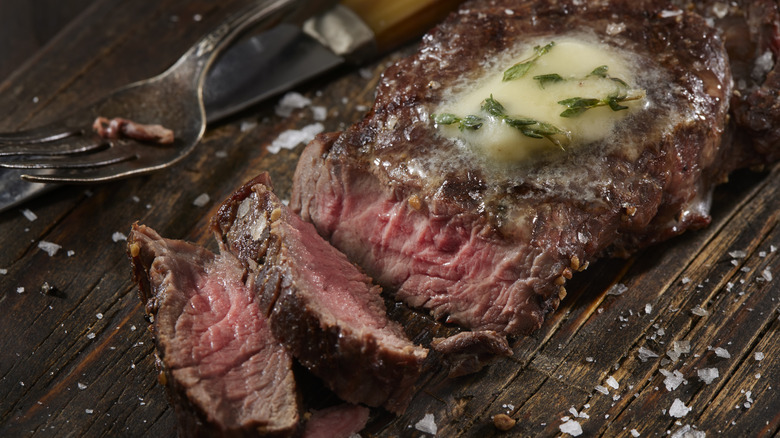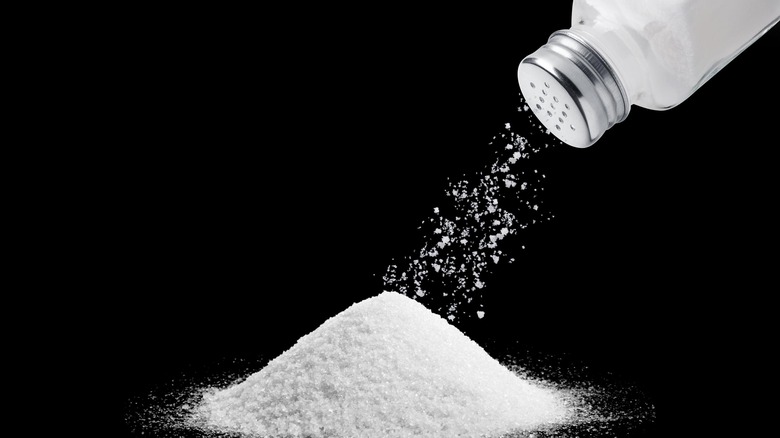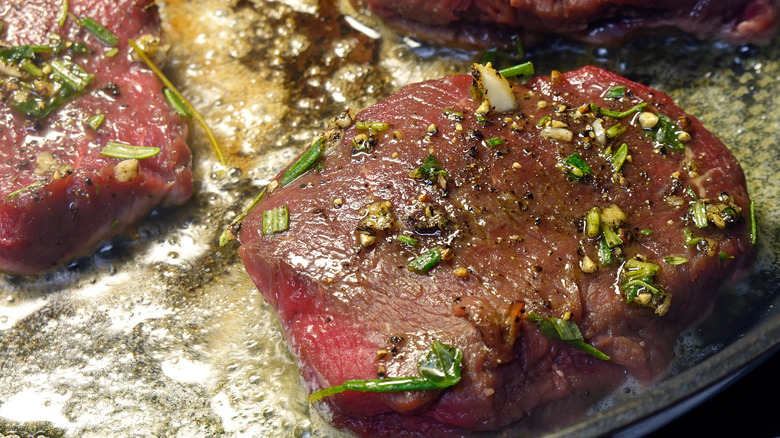The Most Important Seasoning Tip When Cooking Venison Steaks
If there is an underrated cut of meat, that honor unequivocally goes to venison. Not one of the first proteins that spring to mind when shopping for a holiday feast, venison often gets accused of being gamey or tough. There are ways to avoid the gamey taste by soaking the meat in milk before cooking, but to all those people who continue to insist on sleeping on venison, it may be that you just aren't cooking it correctly. One of the biggest mistakes you can make is seasoning venison like a normal steak. The phrase "venison steaks" may suggest that they're no different than a cut of beef, but this is where it gets tricky.
Vension typically refers to deer meat, but can also include caribou, elk, moose, and antelope meat. While steak lovers may be quick to salt a filet or t-bone, over-salting venison is a recipe for disaster. Dryness is the most common adversary to any meat dish, and salt is often the catalyst. As venison is already a lean cut of meat, salting heavily can turn the flavorful meal into something you can't sink your teeth into. Does this mean that salt is off the table entirely? Not necessarily. There is a way to give venison a flavor kick while still maintaining its tenderness.
The best way to salt venison
You don't have to sacrifice flavor with venison: Just because you can't treat it like beef, doesn't mean you can't have a different-yet-still-delicious course. Salting before cooking the meat typically isn't the best way to season venison, as this can actually draw moisture out of the steak, resulting in dryness. Venison cooks quickly, especially on high heat, and you can still incorporate salt after it's been cooked. You can then control your salt intake without compromising on the meat's tenderness.
There is also the option of using a marinade prior to cooking. Meat can be saturated with many flavors, and depending on how long you let the cut sit in the marinade, the venison has more opportunity to stay moist. This strategy also allows for the addition of salt. Adding a pre-determined amount of salt to the mixture adds to the taste while avoiding drying out the meat. Venison is notoriously fickle, and can cause a lot of problems in the kitchen if you're not careful. Even if you have the salting hack under your belt, there are other techniques to creating a well-seasoned, juicy venison steak.
Add fat to create a juicy venison steak
Many of the pitfalls of cooking venison is assuming it is just like beef. This assumption can cause kitchen mishaps and a final result that has the consistency of shoe leather. The fat in beef is what keeps it moist, no matter what you do with it. Venison fat is a different story. Because deer meat is so lean, there isn't a lot of fat to begin with, and many people opt to trim off the fat anyway, as it can adopt a candle-like texture while cooking.
To keep moisture and encourage flavor, it's best to add alternative fats while cooking, as venison can easily become dry and overcooked. About halfway through cooking your steak on the pan, add in a few tablespoons of butter, along with some garlic and herbs if you desire. Then, tilt the pan to one side and scoop this mixture repeatedly over the meat until it's done — this is a process known as butter-basting. You can also use other fats, like tallow, ghee, lard, or even olive or avocado oil, which will all help seal in moisture and promote a flavorful final dish. Just make sure to cook your venison quickly on high heat to avoid drying out this delicious and underrated meat.


